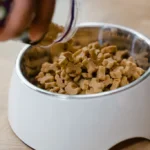Every dog owner wants the best for their pet, including providing them with a balanced and nutritious diet. While many of us are familiar with the importance of protein and fats in our dog’s meals, fiber often gets overlooked.
Whether you’re feeding your pet dry dog food or considering other dietary options, understanding the role of fiber can make a difference in your dog’s overall well-being.
Table of Contents
Different Types of Fiber Your Dog Needs
Two primary kinds of fiber can be found in a dog’s diet: insoluble and soluble. Both types are crucial for optimal digestive health but serve different bodily functions.
- Soluble fiber: Soluble fiber dissolves in water, forming a gel in the intestines. This type of fiber regulates blood sugar levels by slowing glucose absorption. Soluble fiber also promotes the growth of beneficial bacteria in the gut, aiding digestion and boosting the immune system. Common sources of soluble fiber for dogs include oats, peas, beans and certain fruits like apples.
- Insoluble fiber: Insoluble fiber does not dissolve in water. Instead, it adds bulk to the stool and helps it pass through the digestive system. This type of fiber is essential for preventing constipation and ensuring regular bowel movements. It can be found in whole grains, wheat bran and vegetables such as carrots and broccoli.
How Fiber Regulates Your Dog’s Bowels
Fiber regulates your dog’s bowel movements and overall digestive health. A diet high in fiber can benefit your pup in several ways, including:
- Promotes regularity: Insoluble fiber adds bulk to the stool and ensures that waste moves through the intestines at a healthy pace. This prevents constipation and ensures regular bowel movements.
- Absorbs excess water: In cases of diarrhea, soluble fiber can help by absorbing excess water in the intestines and firming the stool. This can be beneficial for dogs with occasional or chronic loose stools.
- Feeds beneficial gut bacteria: Soluble fiber acts as a prebiotic, providing food for the beneficial bacteria in the gut. A healthy gut microbiome is essential for optimal digestion and nutrient absorption.
- Detoxification: As waste moves through the digestive system, fiber can help bind to toxins like heavy metals and unwanted substances, aiding in their elimination from the body.
Which Foods are the Best Source of Fiber?
While dogs primarily require a protein-based diet, fiber can still be a valuable addition in moderation. Introducing Bernie’s high-fiber foods gradually and consulting with your veterinarian to ensure the diet aligns with your dog’s specific needs is essential. Consider adding these high-fiber foods to your pup’s diet:
- Pumpkin: Plain, cooked pumpkin (not pumpkin pie filling) is an excellent source of soluble fiber and can help with both constipation and diarrhea.
- Sweet potatoes: These are rich in dietary fiber and can be included in a dog’s diet as a healthy treat or mixed with their regular food.
- Green beans: Low in calories and high in fiber, green beans are an excellent option to add bulk to a dog’s diet.
- Carrots: Carrots are crunchy and delicious and a great source of dietary fiber.
- Oats: Cooked plain oatmeal in moderation can be a source of soluble fiber for dogs, but it should be free of added sugars or flavorings.
- Brown rice: When cooked, brown rice is a whole grain that contains fiber and can be included in a balanced diet.
- Apples: Apples, without seeds or core, can provide fiber, vitamins and a satisfying crunch for dogs.
- Broccoli: Broccoli, when fed in small amounts, can offer fiber and other nutrients. It’s essential to ensure it’s cooked and chopped into manageable pieces.
You can also find numerous high-quality, high-fiber ready-made options such as RawMix dog food or even freeze dried dog food that you can rehydrate. Look for RawMix options containing fiber sources like carrots, apples, blueberries, kelp and flaxseed. For freeze dried options look for ingredients such as blueberries, fenugreek seeds, pumpkin seeds, sunflower seeds, spinach and kale.
Always talk to your vet before changing your pet’s diet and introduce new food slowly over several days to prevent upsetting their digestive system. It also allows you to monitor your dog for adverse reactions such as food intolerance and allergies.
How Much is Too Much Fiber?
Overloading your dog’s diet with fiber can lead to various digestive issues, such as flatulence, bloating and vomiting and may interfere with the absorption of essential nutrients.
The optimal fiber content can vary based on a dog’s needs, age, activity level and health conditions. However, a diet consisting of 2.5-4.5 percent fiber is generally recommended for most adult dogs.






